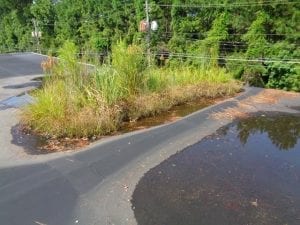Effects of Ponding Water
The Effects of Ponding Water
No matter what type of roof you have, the effects of ponding water can adversely affect your roof system and it can get costly. Proper design, installation, and maintenance can prevent ponding and the problems that come with it.
The National Roofing Contractors Association (NRCA) defines ponding water as water standing on a roof for 48 hours or more. Most codes require ¼” per foot slope when installing roof systems. This slope usually ensures that the roof drains freely.
Top 4 Effects of Ponding Water
Algae & Vegetation Growth
Algae and Vegetative growth can cause damage to the membrane, having root growth into the roof. It can also clog roof drains.
Safety
When single-ply membranes have ponding water, they become very slippery. A simple walk to look at anything on the roof can result in a fall and injury.
Overloading the Structure
Water is heavy. One gallon of water weighs 8.3 pounds. Depending upon depth, a large pond can weigh upwards of a couple of thousand pounds.
Leaking through the Membrane
It only takes a small amount of moisture getting into the system to reduce the thermal value of insulation, deck damage, and damage to the building’s interior. Consider 20 or 30 gallons of water coming in versus a small leak. It makes a big difference not only in damage but inconvenience as well.
Some manufacturer’s warranties are not explicitly defined, or they don’t have an exclusion for ponding water. Is it less expensive than using tapered insulation? Absolutely, but what will it cost if the unthinkable happens?
Addressing these factors prior to installing a new roof or reroof can help extend the service life of your new roof and help eliminate costly leaks. Contact Spann Roofing.

